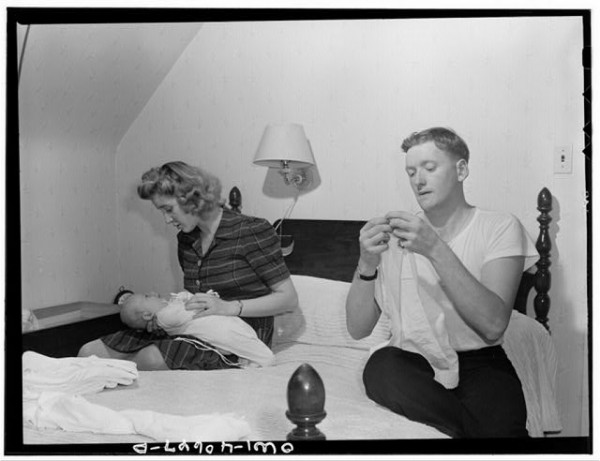The diaper business is a great one to be in. Why? Every baby wears them and babies are born every second. This was even true in the mid 1940’s. Yet during what was an incredible baby boom for America, there was a diaper shortage facing families.
The headlines read “Diaper Stretch Need Figured” (1944), “Diaper Service Crisis Averted” (1944), “Stork Wins Race With Diaper Looms” (1945), “Things Better on Diaper Front But Beware of Winter ” (1946), and the best one “Fatherless Blamed for Diaper Shortage” (1946).
 It is hard to imagine as Americans (and others living in industrialized nations) a time when at any moment necessities could be cut short. This was the reality for America in war-time. During the years of 1942-1946 the government began a rationing program. Many staple items including food, gas, and clothing were strictly controlled. The raw materials were diverted to the war-time effort. Propaganda posters including the one pictured, encouraged the families at home to do with less in order to save provisions and allow the labor at home to support the soldiers and the military needs.
It is hard to imagine as Americans (and others living in industrialized nations) a time when at any moment necessities could be cut short. This was the reality for America in war-time. During the years of 1942-1946 the government began a rationing program. Many staple items including food, gas, and clothing were strictly controlled. The raw materials were diverted to the war-time effort. Propaganda posters including the one pictured, encouraged the families at home to do with less in order to save provisions and allow the labor at home to support the soldiers and the military needs.
Diapers were no different. During the years of 1944-1946, according to several local newspapers that covered the story, there was a shortage. Just like today, it seems Congress was to blame! The War Production Board ordered in 1944 that the diaper supply for services be prioritized thusly: 1. Hospitals. 2. Private Homes in which the urgent need for service is certified by hospitals, doctors, and midwives. 3. Private home with new babies. 4. All others. Being that the shortage had already begun, it was the opinion of the journalist in one article that “all others” would likely never see the diapers.
The government had diaper needs down to a science, if you can imagine! The 1944 diaper cloth production was 34 yards for each infant. They knew however, that in war-times there is a baby boom and predicted that there would be an increase of 31 percent in babies under two. Officials worried that supply would not meet the increase in demand that was ahead. In 1945 looms increased production from 46,000,000 to 92,000,000. In a hearing to address the clothing and diaper shortage held in 1945, the War Production Board declared that looms making diapers would only be for making diapers and that the Army was prohibited from using diaper cloth for cleaning guns and industry. By their calculations, diaper services had enough for 3 dozen diapers a child. Their conclusion was that there wasn’t a diaper shortage.
Just like today, one side of the fence claimed that there was no diaper shortage at all, yet the American public and the diaper service industry were all feeling the pinch.
The National Institute of Diaper Services got involved; the general counsel Stanley I. Posner said this at their convention in 1946 “Too many government officials have forgotten about the task of diapering infants. Mothers can’t cloth babies in red tape.” He went on to say “the day of clothing babies in flour sacks is over but apparently some Washington officials don’t realize that. If they had an infant in their home, they’d probably realize how essential diaper services are in this era of housing shortages and lack of domestic help.”

Diaper services, even during wartime, were growing. They were also struggling to meet customer demands due to the various rations but at the same time were benefitting from them. According to Warren Childs in his memoir about the Dydee Diaper Service that operated from 1938-present- “We did grow though, in spite of ourselves. People could not get soap, diapers, washers, or dryers. Besides, housewives were going into the war industries to work and did not have the time to do their diapers.” In his memoir he gives a glimpse into the war-time rations, noting that he reduced his gas usage by half, but was then asked to half it again. They scrounged up barely enough ration coupons for gasoline to fuel their trucks that were used to pick up and deliver the diapers on their routes. Warren passed away in 1990 but his service is still operated by his sons.

Even after the war ended, in 1946 families were still facing shortages due to the increase in population (as predicted). “More diapers are being made than ever before but we still don’t have enough.” said John K. Jones, president of the National Institue of Diaper Services. His solution? A new fold to get more mileage out of a diaper. We know this fold as the “kite fold” today. He demonstrated using a handkerchief from his pocket “take the opposite corner of the diaper and fold them in so that it resembles a kite. Then take the bottom tip and fold it up so that it reaches would would be the cross-piece of the kite. Turn down the top.” The extra thickness in the middle would let diapers last longer than the more basic triangle fold likely being used at the time.
[hr]Sources: Oxnard Press-Courier – The Miami News – Dec 19, 1944, Jan 16, 1945, Daytona Beach Morning Journal – Jun 15, 1946, The Tuscaloosa News – Oct 11, 1946, How Our Business Got Started by Warren Childs, 1979.
[hr]Did you enjoy this article? Also see “The Invention of the Modern Cloth Diaper” and my video interview “Cloth Diapering in the 1950’s.” You can also follow my Historical Cloth Diapers Board on Pinterest.





